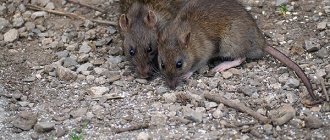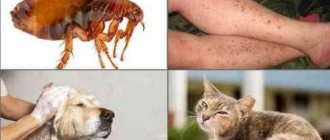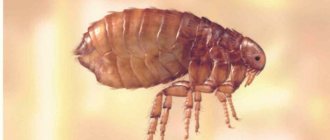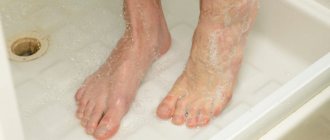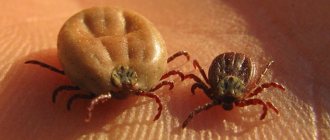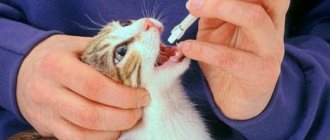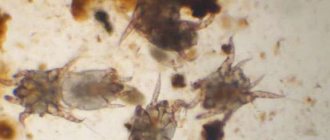Do chinchillas have fleas?
Chinchillas are friendly, undemanding pets.
Animals get sick a little and do not need special care. However, chinchillas sometimes have fleas. For their owners, this information often comes as a surprise. After all, animals are kept in comfortable, homely conditions and do not leave their home.
Also, many believe that chinchillas do not have fleas because rodents have thick fur and bathe in sand. Indeed, animals do not have their own parasites. But pests can be brought in from the street by cats or dogs.
Other routes of infection:
- fleas enter the house by clinging to people's shoes or clothing.
- Attics or basements are favorite habitats for blood-sucking insects. Through cracks and small openings, parasites easily enter a person’s home.
- Sometimes an animal may already be infested with fleas, for example, in a pet store.
- Parasites are often found in hay that is placed in a rodent's cage.
After landing on the body of the intended host, the insects find places where there is the least amount of hair. These are ears, muzzle or paws.
What to do if a chinchilla itches or bites itself - find out the cause of the symptom
Ectoparasites are parasites that live on the outer surface of the body of an animal or human. These include fleas, lice, and ticks. Chinchillas are infected with them relatively rarely due to their dense fur, but this possibility cannot be excluded until examination and testing are carried out. The presence of parasites is detected by characteristic symptoms:
- the animal bites its fur, twitches and rubs its back against the wall;
- scratches the skin until it bleeds due to severe itching;
- the fur becomes brittle and falls out, especially on the head and paws, where it is less dense;
- bleeding ulcers and bumps appear on the skin;
- in serious cases there is swelling and suppuration.
To prevent your pets from becoming infected with ectoparasites and fungi, you need to follow several rules:
- buy quality food and fillers;
- wash the cage and walking areas every day;
- Completely disinfect the cage at least once a month;
- keep chinchillas in a spacious enclosure;
- ventilate the room regularly;
- before adding a new resident to the enclosure, place him in quarantine for 1.5 months;
- wash your hands and change the clothes you came in from the street in if you are going to touch the animals;
- Include essential vitamins and minerals in their diet.
If tests do not show infestation with parasites, the chinchilla may chew out its own fur due to stress associated with moving or moving in with relatives. In this case, she is moved to a separate cage for several days, covered with a dark cloth. Other causes of biting include vitamin deficiency, allergies, and other diseases.
Chinchillas are neat, furry pets that have earned recognition from many lovers of exotic animals.
There is an opinion that keeping strange animals at home and having thick, dense fur exclude the possibility of small rodents being affected by various ectoparasites: fleas, ticks or lice.
Unfortunately, these are misconceptions of inexperienced chinchilla breeders, so if a chinchilla itches and bites itself, it is urgent to show the animal to a specialist.
Chinchilla owners often ask whether chinchillas have fleas or other ectoparasites and where they come from.
Parasitic insects can live on different types of domestic animals and enter the apartment from basements and sewers.
A small animal can become infected through litter, hay, contact with infected pets, most often dogs and cats; even a tenderly loving owner sometimes brings parasites into the house on clothes or hands.
We invite you to familiarize yourself with cockroaches in your apartment, what should you do?
Checking your chinchilla for fleas
Fleas prefer warm, moist places to live, ideally the fur of warm-blooded animals. This applies to the most common types of parasites - cat and dog bloodsuckers, which are no different from each other in their lifestyle. At the same time, they lay eggs on litter and other warm, hidden places. Having brought a playful, affectionate animal into your home, immediately carry out a preventative examination. Especially if he itches and bites the skin. Blood-sucking insects prefer to live on the legs and ears, since there is less fur there compared to the body. If there are no fleas, the skin is clean, smooth, without ulcers or scratches. If the above signs are found, this indicates the presence of parasites.
Important! The assumption that chinchillas do not have fleas is wrong. Their fur is thick and their love of swimming in the sand is considered a good prevention of their appearance. However, if there are insects in the apartment, chinchilla infection is inevitable!
How to remove fleas from pregnant dogs
Pregnant bitches, like small puppies, are very susceptible to external influences, so it is advisable to use traditional medicine recipes for their treatment and antiparasitic treatment. However, in cases of severe flea infestation, ready-made veterinary preparations, such as Frontline or Advocate drops, will be relevant. If the expectant mother is calm about bathing, you can use special flea-killing shampoos.
Important! If you do not rid a pregnant female of fleas in a timely manner, newborn puppies will certainly become infected with them, which in some cases is dangerous not only for their well-being, but also for their development in general.
How fleas get into an apartment
If you are interested in the question of why your chinchilla itches and bites itself, check it for fleas, even if it is the only animal in the house. After all, bloodsuckers can get into a city apartment or private house in several ways:
- flea larvae or young, active insects can be carried on clothes and shoes;
- through ventilation shafts, openings;
- with sand and food, even purchased in a store;
- and the most common option is with pets who prefer warm, damp places for walking - basements, attics, sheds.
Important! If fleas are detected, you should start fighting immediately, because one mature individual lays a large number of eggs per day, which, under favorable conditions, turn into an adult insect within a few days.
How do chinchillas get fleas?
Can a chinchilla get fleas if it is always in a cage and not in contact with other animals? This question worries many owners of cute animals. In fact, bloodsuckers can settle on the thick skin of the animal:
- jumping over other pets;
- coming from attics, basements;
- from sand or hay, which are used for bathing, animal bedding;
- from carpets, upholstered furniture and other items in the house, if the room was infested with fleas even before the animal appeared;
- having settled on an animal in a pet store or market.
Important! Dogs and cats are the main sources of the spread of blood-sucking insects, especially if they are outdoors. Flea collars are not a 100% guarantee of sterility!
Where do fleas come from?
Many owners are concerned about the question: how can a chinchilla get fleas if she never leaves the house and rarely leaves the cage? In fact, being an outdoor animal is not at all necessary to get to know fleas better. It is enough if other animals live in the house besides the chinchilla.
The basement is one of the ways fleas get into the house
- that is especially dangerous in this regard for rodents is a dog that is outside every day and can bring fleas at any moment. The presence of a flea collar on a dog does not guarantee its absolute sterility in this regard. Fleas can still get on your dog on the street. Therefore, it is very important to promptly treat your dog for fleas using traditional or home methods.
- Fleas move quickly and over long distances, sensing the blood of warm-blooded animals. Cats can also spread fleas .
- Other ways fleas enter the house are from basements and attics , where they parasitize stray animals and birds. Ventilation shafts only facilitate this process.
- Sometimes a chinchilla comes into the house already infected with parasites , having received a problem from a guinea pig, which can be eliminated from fleas using folk or store-bought remedies. Therefore, you need to inspect the animal immediately after purchase or even before that.
- Another source of danger is chinchilla hay It may be infested with fleas. Therefore, before putting your favorite treat into the cage, it must be carefully inspected.
What to do if your chinchilla has fleas
Do not worry. This is a serious problem, but completely solvable. You need to go to the pharmacy and buy an anti-flea collar for kittens or small dogs. The use of drops such as “Bars”, “Stronghold” is fraught with poisoning : the rapid metabolism characteristic of rodents makes chinchillas very vulnerable to various chemicals.
Under no circumstances should you use anti-flea shampoos. In nature, chinchillas live in deserts and almost never encounter enough water to wet their fur. Bathing is a serious stress . In addition, the risk of catching a cold .
After putting a collar of a suitable size on the animal, you should proceed to measures aimed at exterminating fleas and their larvae in the home.
- Wash the chinchilla's cage with a solution of tar soap and vinegar.
- Change the sand in the sand bath.
- If there are other animals in the house, treat them for fleas too.
Carefully . If you remove the collar from the animal too early, it may become infected with fleas again. This happens for the reason that the parasite eggs, once on the floor, turn into larvae, which after 7-10 days give rise to a new generation of bloodsuckers.
To avoid re-infection , thoroughly wash the floors with a special product from a veterinary pharmacy. The floor treatment will need to be repeated after 1-2 weeks to destroy the newly hatched larvae and prevent them from pupating and laying eggs.
Do chinchillas have fleas and what to do – Pest Control
Chinchillas are very friendly and unpretentious animals. They rarely get sick and, with proper care, do not cause their owners much trouble. Therefore, if a chinchilla has fleas, you should immediately remove them to avoid more serious problems.
It is believed that chinchillas do not get fleas, since this is prevented by the animal’s thick, dense fur, but this is a mistaken opinion. Parasites can choose less protected places on the animal’s body: paws, muzzle, ears. Flea bites are very painful for chinchillas and can cause itching, purulent inflammation at the site of the bite, allergic reactions and dermatitis.
Causes of infection
The chinchilla spends most of its time in a cage where there is special chinchilla sand for cleaning the skin, so there is no threat of infection from this side.
But if there are other animals in the house that often go outside (dogs, cats, rabbits), then there is a risk of contracting parasites from them.
Fleas easily move long distances and quickly sense the presence of warm-blooded animals, so they can easily get to chinchillas from other pets.
It happens that an animal enters the house already infected, so when purchasing an animal, carefully inspect it.
Another source of infection may be hay, which is a favorite treat for animals, purchased from an untrusted place. It can easily contain fleas. You should inspect it carefully before placing it in a cage.
Fleas that attack chinchillas are small, about 3 mm in length, but very jumping. They easily cover long distances and can live without food for a long time.
Warm and humid rooms provide ideal conditions for their reproduction; they lay eggs in floor cracks and behind baseboards.
Therefore, if parasites are found in the apartment, it is necessary to immediately carry out sanitary treatment in order to ensure that they get rid of them.
Ways to fight
It is quite difficult to notice fleas in your pet’s thick fur, so you should pay attention to less protected places: paws, muzzle or ears. Fleas resemble small black dots, and their bite marks look like small growths like warts
Fleas resemble small black dots, and their bite marks look like small growths like warts.
The reaction of chinchillas should alert owners: the animal becomes restless, scratches the bite sites, where inflammation and ulcers can form. The animal's fur becomes dull, and bald spots remain in places where hairs fall out.
It is necessary to carefully treat the animal's fur, but remember that flea products intended for cats and dogs are absolutely not suitable due to the small size of the animal.
Doses of chemicals for chinchillas should be several times smaller, so the best solution would be to use a flea product for kittens, diluted by half, or purchase a special anti-flea collar for small dogs.
In this case, the harm will be minimal.
According to reviews from many chinchilla owners, Frontline flea spray, intended for cats and rabbits, has proven itself well.
But it should be used carefully so as not to harm the small animal.
All other pets should also be treated with anti-parasite products. It is necessary to thoroughly wash with tar soap or change all the bedding, replace the sand in the chinchilla’s cage, and in the future, when taking your pets outside, put on a flea collar that repels parasites.
If all of the above measures do not help get rid of parasites in the house, you should contact a specialized company, whose employees will sanitize the premises with a guaranteed result.
What to do if your chinchilla has fleas
Chinchillas are very friendly and unpretentious animals. They rarely get sick and, with proper care, do not cause their owners much trouble. Therefore, if a chinchilla has fleas, you should immediately remove them to avoid more serious problems.
It is believed that chinchillas do not get fleas, since this is prevented by the animal’s thick, dense fur, but this is a mistaken opinion. Parasites can choose less protected places on the animal’s body: paws, muzzle, ears. Flea bites are very painful for chinchillas and can cause itching, purulent inflammation at the site of the bite, allergic reactions and dermatitis.
Inspection rules
To understand whether there is a problem, you need to examine your pet's paws and ears. In these places, the fur is sparse and the skin is thin. Sometimes parasites settle on the stomach and head. A flea can live on a chinchilla's back, but this area is the last area to become infected.
It is extremely rare to see parasites through fur. In the event of any threat, insects quickly hide in thick fur, so a person does not have time to notice them. However, brown feces and flea eggs can be seen on light-colored fur. The latter look like small dark grains.
You can understand that a chinchilla is infected by the following indirect signs:
- Itching. Appears in the early stages of a pet. It disturbs the animal even during sleep.
- Bites. Marks appear on the skin that can be confused with rashes.
- Deterioration in appearance. With severe infection, the body becomes depleted. The chinchilla is losing weight and losing hair.
- Anemia. With the development of anemia, the mucous membranes become pale.
Chinchillas have quite thick fur and it is very difficult to see the insect during inspection.
How do symptoms appear?
The most obvious symptom is a sudden change in behavior. In the early stages, your chinchilla may become overly active. She runs around the cage restlessly and scratches herself. Irritability increases and aggression may appear. Later, due to poor sleep, the rodent becomes lethargic. His daily routine is disrupted. In severe cases, the pet develops apathy. He reacts poorly to attention, food and games.
Bites appear on the animal's skin. They may resemble rashes or warts. If an allergy to flea saliva develops, additional symptoms may develop. The chinchilla may experience discharge from the eyes, sneezing, etc.
Hair loss in an animal may indicate the presence of fleas.
Symptoms of infection
You can understand that a chinchilla has parasites if it:
- changes his behavior beyond recognition, for example, becomes too restless;
- constantly itches or rubs against the sides of the cage;
- combs out wart-like growths;
- scratches and tries to remove small black specks on his body;
- suffers from hair loss and bald spots;
- has too dull coat.
Important! Never use anti-parasite products for cats or dogs on chinchillas. These thick-haired animals are much smaller in weight, so this dosage will be fatal to your rodent. It is better to use a special flea collar.
How to remove fleas from a chinchilla
Veterinarians and owners of furry rodents who have encountered a similar problem know what to do if a chinchilla has fleas. Removal of blood-sucking insects consists of two stages. First, the animal and its cage are disinfested.
Further, if necessary, measures are taken that involve the use of antiparasitic agents.
To get rid of fleas forever, you need to disinfect the entire house. For treatment, you can use special insecticidal or folk remedies.
Other important detoxification activities:
- washing of all bedding and rugs.
- Treating other domestic animals with insecticides.
- Applying antiparasitic agents to all secluded places (floor, baseboards, furniture).
During detoxification procedures, it is necessary to remove animals and people from the home. Several hours after treatment, ventilate the premises, wash floors, surfaces or vacuum them.
For the complete disappearance of fleas, repeated antiparasitic measures are recommended.
Processing the cage and animal
To get rid of pests forever, it is not enough to know how to remove fleas from a chinchilla. For the absolute destruction of insects, the use of insecticides or collars is not enough.
To prevent pests from appearing in your pet again, you need to thoroughly clean the animal’s cage.
For this purpose, the following activities are carried out:
- Sweep out all the trash (droppings, crumbs, leftover food).
- Change hay and sand.
- Treat the cage with a mixture of tar soap and vinegar.
- Boil the litter and disinfect it.
After treatment, it is advisable to place the chinchilla cage in the open air for 2-3 hours. Moreover, it is advisable to place it under the sun's rays.
Antiparasitic agents
After disinfecting the apartment and cage, it is necessary to take the animal to the veterinarian for examination. The doctor will examine the animal and then advise how to rid the chinchilla of fleas.
Often, if parasites are present, the doctor prescribes drops or sprays. Frontline is considered an effective remedy for blood-sucking pests. The drug is produced in the form of a spray or drops, which are used in a minimal dosage.
Other popular flea treatments for chinchillas:
- Advantage (drops);
- Fogger (spray);
- Lawyer (drops);
- Canina Bio (biospray);
- Le Artis (spray);
- Bars (spray);
- Palladium (spray);
- Butoxept (spray).
The chinchilla is a small animal that is very sensitive to chemicals. Therefore, the use of toxic agents in large doses can cause intoxication in a rodent.
The dosage of any antiparasitic agents should be minimal. Veterinarians recommend using doses intended for kittens or puppies.
For those who do not want to take risks in order to prevent rodent poisoning, doctors recommend that they refrain from using chemical antiparasitic drugs. You can simply put a collar on the rodent. It will not harm the chinchilla, as it is considered a less toxic product.
Also, veterinarians do not recommend using pest control shampoos.
After all, the natural habitat of chinchillas is the desert. Rodents never wash themselves. Moreover, water can accumulate in the animal’s dense fur. This will increase the likelihood of your pet getting a cold.
Video
How to remove a chinchilla cage.
Respiratory diseases in chinchillas
With these diseases, the chinchilla becomes lethargic, breathing is shallow and rapid, wheezing is sometimes heard, and the animal loses its appetite. The reasons may be drafts, low temperature or high humidity in the room. Among medications, bicillin is used intramuscularly, 10-15 thousand units once every 5 days. You can give an aqueous solution of ampicillin. To do this, dissolve 1 tablet in 100 ml of water and pour it into the mouth using a syringe or pipette 3 times a day for two to three days (the solution is prepared fresh each time).
Runny nose
A runny nose usually occurs in late autumn or spring as a result of a cold in drafts or dusty rooms. The nostrils of sick animals are wet and mucus flows from them. First white, then yellow mucus also collects in the corners of the eyes. The animals are sleepy, wag their tails, and have rapid breathing. It is necessary to eliminate the cause of the cold. Treatment consists of washing the eyes with a two percent solution of boric acid, tea or a weak solution of potassium permanganate. Animals are given an increased dose of vitamin C (rose hip syrup: 1 tablespoon per 100 ml of water). You can read more about colds in chinchillas here.
Hyperemia of the lungs in chinchillas
This disease occurs as a result of keeping animals in the summer in stuffy rooms with poor ventilation, as well as when inhaling hot air or poisonous gases. Symptoms of pulmonary congestion are the following: rapid heartbeat, increasing shortness of breath, attacks of suffocation, and sometimes a hoarse cough. Foam with a reddish tint may be discharged from the nasal passages.
Animals should be kept in a cool, ventilated area during treatment. If the cause of the disease is overheating, the animals are doused with cool water and bloodletting is immediately performed (it facilitates the work of the heart, lowers blood pressure in the lungs, resulting in improved ventilation). In addition, cardiac medications (cordiamin, caffeine), as well as laxatives and diuretics are used. If complications occur, antibiotics and sulfonamides are prescribed.
Inflammation of the mammary gland
This disease occurs in females when the nipples are damaged. The gland is red or bluish, swollen and painful. The animal is lethargic, refuses food, and its body temperature is elevated. For treatment, penicillin is used intramuscularly in the amount of 100 thousand units per day for three days, or oxytetracycline is given with water (a teaspoon per 100 ml of water). The mammary glands are lubricated with tetracycline, penicillin or levomekol ointment. Abscesses are treated surgically by incising the gland to remove pus and washing the wounds with a penicillin solution.
Heatstroke
Chinchillas are very sensitive to temperatures above 26° C and at the same time high air humidity. Under such conditions, heat stroke often occurs. The animals lie motionless, stretched out; breathing is short and rapid, the ears are red, and the body temperature rises to 38° C. If measures are not taken, the chinchilla may die. The animal should be immediately moved to a cool, shaded place, and a cold compress from a bag of frozen vegetables or a cloth soaked in cold water should be placed on the head. The bandage should be soaked in cold water as often as possible. If this happened in transport, the cage must be lowered down, where the air is cooler, an ice pack or a bottle of cold water should be placed, and the cage should be shaded. After providing first aid, it is best to show the animal to a veterinarian.
When leaving home, make sure that the cage is in a place where direct sunlight will not constantly shine; the animal should have a shaded corner where it can hide if necessary.
Lack of vitamins
Some ailments, similar to the symptoms of the disease, can occur due to a lack of certain vitamins and minerals. Thus, a lack of vitamin A causes inflammation of the mucous membrane of the eyes. It is necessary to increase the dose of this vitamin in the diet. With a lack of vitamin B1, attacks occur in which the animal trembles, drags its hind legs, movements are difficult, and coordination is impaired. In severe cases, there is a high probability that the animal will die. It is necessary to inject a five percent vitamin solution into the thigh muscle with an insulin syringe. The dose is no more than two small divisions on the syringe markings.
If it is impossible to diagnose the disease or cause of the illness on your own, you must call a veterinarian or take the animal to a hospital.
The main parasites of chinchillas
There are several types of ectoparasites that are found in chinchillas.
Fleas
These wingless insects jump high and cling to animal fur with their claws and bristles. The flea's body length ranges from 1 to 5 mm, and its mouthparts are designed to pierce the host's skin and feed on blood. They carry pathogens of dangerous diseases such as typhoid, plague, and hepatitis.
Chinchillas can become victims of cat, rabbit and rat parasites. When infected with fleas, the animal itches, hair falls out, and bites resembling warts appear near the face and on the limbs. Insects can be detected by parting the fur.
Lice and lice eaters
Both types of parasites live in the fur of mammals; the sizes of individuals vary from 0.5 to 10 mm. Lice feed on blood, and lice eaters feed on blood and skin particles. They reproduce quickly, laying white eggs - nits that stick tightly to the hair.
These insects also carry infections that are dangerous to people and pets. Their bites cause severe itching and anxiety in animals, as well as scratching on the skin.
Ticks
Chinchillas are parasitized by subcutaneous and ear mites that live in the upper layer of the epidermis. Because of them, bumps, peeling and crusts appear on the skin, the animal often itches and experiences severe discomfort.
The diagnosis is made after microscopic examination of the scraping. Curing a pet from ticks is quite difficult and is often possible only in the initial stages: first, the animal is cut, then washed in a 0.5% bromocyclene solution 4 times at intervals of 8 days.
Ringworm or fungus in chinchillas
If your pet itches and bites itself, the cause may be a fungal skin disease - ringworm, or ringworm. Signs that distinguish the disease:
- hair loss in certain areas;
- peeling of the skin;
- formation of crusts and red spots;
- sometimes discharge of pus from wounds.
A chinchilla usually easily tolerates the disease, but if it is neglected, the animal can become completely bald, and the fungus can also affect other organs.
Diagnosis is carried out using an ultraviolet lamp in a dark room: with dermatomycosis, areas of the skin glow green. This test does not detect ringworm caused by some types of fungi; in such cases, skin and hair samples are taken for microbiological analysis.
Factors that increase the risk of disease:
- chronic stress;
- avitaminosis;
- malnutrition;
- high air humidity;
- poor hygiene;
- contact with the vector.
Ringworm is an unpleasant disease, but relatively easy to treat. Therapy is prescribed by a veterinarian; drugs such as clotrimazole, lamisil, exoderil, etc. are usually used. There is a vaccine against fungus that is administered to chinchilla puppies after 6 months.
Ringworm is easily transmitted to humans, so a sick animal should be isolated and touched only with gloves.
Non-contagious diseases of chinchillas
There are also diseases that cannot be transmitted from pet to owner.
It's not about their animal origin. It is ironic that these arise mainly due to the fault of the owner, due to his inability to create suitable conditions of detention. Below we will consider diseases that are classified as non-communicable.
Cold
In chinchillas, colds occur in case of hypothermia or blowing - exposure to a draft, moving the house to a cool room. When a chinchilla has a cold, it breathes heavily, its nose becomes wet, and sneezing and coughing appear.
To cure a cold, the owner will have to give the chinchilla an injection. The pet is given a five-day course of antibiotics.
Stress
Stress can appear after experiencing shocks. A stressful state is dangerous due to the possible development of more serious problems and diseases that can lead to the death of a pet. To overcome it, you will have to reconsider your pet’s life and start paying more attention to it.
Many chronic diseases and complications can develop from stress. Sometimes a chinchilla has a stroke due to stress, and sometimes serious pathologies appear.
Heatstroke
Such a nuisance can occur after overheating - for example, prolonged exposure to the sun. Emergency help in this case is to move to the shade and cool with a moistened (but not wet) towel.
Injuries
Various everyday situations can lead to injury. They can be of varying degrees of severity, so your doctor will advise you on how to properly correct the situation. Often it is necessary to immobilize the injured part of the body. Sometimes injuries can lead to death - an excellent reason to remember that care is important when handling a pet.
Sometimes an injection into the back paw is required to numb the damaged area.
How to treat
To reliably get rid of fleas, it is not enough to treat only the chinchilla. Insects can remain in bedding and furniture, so comprehensive measures need to be taken. They start by treating the cell. The chinchilla is temporarily placed in another place. It is better to change the litter completely, but if this is not possible, you can remove debris from the old one, boil it and treat it with a disinfectant solution.
The easiest option is to grind tar soap into shavings, dissolve it in water and add a little vinegar. The entire cage and accessories are also treated with the liquid. Sand and hay are changed.
Houses are vacuumed well, moving furniture away and paying attention to upholstery. Bedding is washed in boiling water to kill the fleas. You can do the same with cat and dog bedding if you have any in the house. If it was not possible to get rid of the parasites and the infection recurs, you will have to treat with an insecticidal solution.
The most accessible and simple remedy is Bars spray. You may have to go somewhere for a day and take your pets to avoid intoxication. Sprays are used to treat the bottoms of beds and sofas, mattresses, crevices behind baseboards and kitchen cabinets, etc. After 10 days, the procedure is repeated to destroy the hatched individuals.
Special antiparasitic agents are produced for chinchillas. Some owners use medications for cats and dogs, but the dosage of active substances in them is different. This may cause side effects. It is recommended to use drugs for rodents; in extreme cases, a minimum dose should be given.
As an alternative, you can purchase a collar for cats and dogs. It contains less active substances. It is not recommended to use flea shampoos, because... A chinchilla may catch a cold after bathing. If there are other animals in the house, they also need to be treated.
One of the options for protecting against fleas is to put a parasite collar on your chinchilla.
Chinchilla treatment
If fleas are found on the animal, it is necessary to begin treatment. Some owners try flea medications designed for cats and dogs, especially if they are available in the home. But we must remember that the chinchilla is a small animal. And the dose of the chemical contained in drops for dogs and cats may be too much for her. This will cause poisoning of the animal. Fluffies themselves are also very sensitive to chemicals.
Therefore, you should not risk your pet’s health and prescribe treatment for it. Powder, sprays and drops are undesirable for them. If fleas are found on chinchillas, it is better to wear a flea collar. It is less toxic and therefore will not harm the animal. Flea collars for cats and small dogs are quite suitable for chinchillas.
Treating a rodent for fleas
Only large-scale disinfection measures will allow you to get rid of fleas not only on the animal’s skin, but throughout the entire apartment. Immediately after detection, it is necessary to remove all inhabitants from the house and carry out disinfection with special preparations - spray or aerosol. You need to carefully treat the areas behind the baseboards, floor cracks, carpets, and upholstered furniture. After this, the apartment is thoroughly cleaned with washing and using a vacuum cleaner. All pets are also treated with insecticides and wearing flea collars.
Chinchillas have fleas, what not to do?
- Use anti-parasitic shampoos designed for larger pets.
- Bathing an animal, for which getting its fur wet can result not only in serious stress, but also a cold.
- Use chemicals such as Bars or Stronghold, which can cause poisoning.
Important! 1-2 treatments of the apartment will be enough for the insects to disappear!
Flea remedies
When using antiparasitic products intended for cats and dogs, it is worth keeping in mind that the chinchilla is much smaller in size than other pets. This means that the dose of the chemical must be reduced. Special sprays and drops can cause significant harm to the animal. Therefore, the best option would be a special collar that is used for cats and dogs. The product is less toxic compared to chemicals and safe for health.
How to get rid of parasites
Never try to cure a chinchilla of parasites on your own using popular pet medications. At best, this will not bring results; at worst, the wrong dosage will lead to poisoning. The veterinarian must make a diagnosis and prescribe the necessary medications.
When treating fleas, a special collar for pets is successfully used. If your chinchilla is infested with insects and there are dogs or cats in the house, they should also be treated.
To get rid of parasites, be sure to disinfect the enclosure, change the filler, bedding and sand. It is also necessary to clean the entire apartment.
Preventive examination
As soon as the animal gets into your home, carefully examine its paws and ears. The fur on these parts of the animal’s body is much less dense than on the body, and parasites prefer to feed there. The skin is clean, no ulcers or scratches found, no insects? Everything is fine. Your animal is healthy.
You can tell that a chinchilla has fleas by indirect signs:
- The chinchilla experiences constant itching and cannot sleep peacefully. Losing weight.
- Dermatitis appears on the skin.
- The fur is falling off.
- Black specks are visible in the fur - flea droppings.
- Anemia occurs - the nose, gums and other mucous membranes turn pale, the animal weakens.
Attention. Many believe that chinchillas do not have fleas, since the thickness of their fur and love for swimming in fine sand prevent parasites from settling in their fur coat. But it is not so. They do not have their own parasites, but cat and dog fleas brought in from the street do not bypass any potential hosts.
Image of the enemy
Chinchillas are parasitized by cat and dog fleas of the genus Ctenocephalides felis . They are several millimeters in size and look like black dots. The flea loves damp and warm places. Needless to say, a chinchilla’s cage can create almost ideal conditions for fleas. The parasite feeds on the blood of animals, and can live for almost a year without food.
Chinchillas are parasitized by cat and dog fleas
Fleas lay eggs not on animals, but on litter, behind baseboards, in cracks, in carpeting. Each flea is capable of laying up to two thousand eggs. It follows that if you do not fight fleas, they will fill the entire house extremely quickly.
Can a person become infected from a sick animal?
Humans can only become infected by fleas of the species Pulex irritans. Therefore, there is a chance of becoming infected with parasites, but it is very small. You may also simply be a carrier of these insects. But you should still be careful, as the flea can carry plague and rabies. Therefore, it is important to regularly carry out preventive measures.
Sources
- https://parazitdoma.ru/blohi/u-shinshilly-chto-delat
- https://klopkan.ru/blohi/vsyo-o-blohah/byvayut-li-blohi-u-shinshill/
- https://hlopklop.com/blohi/blohi-u-shinshill.html
- https://lifeinsect.ru/blohi-u-shinshilly.html
- https://homjakam.ru/shinshilla/zdorovie/cheshetsya-ili-pokusyvaet-sebya
- https://combat-dez.ru/prichiny-i-simptomy-poiavleniia-bloh-y-shinshill/
- https://stop-klopam.ru/blohi-u-zhivotnyh/chto-delat-esli-u-shinshilly-poyavilis-blohi
- https://pets2.me/bok/1629-kak-vyvesti-bloh-u-shinshilly.html
[collapse]

